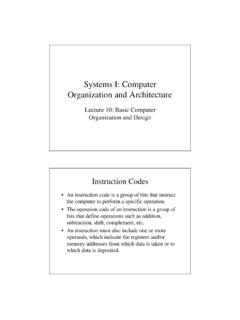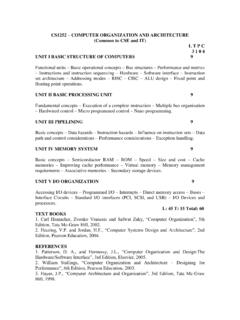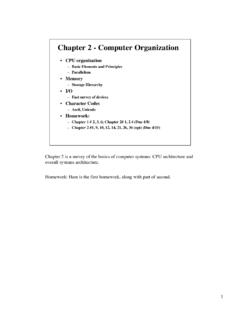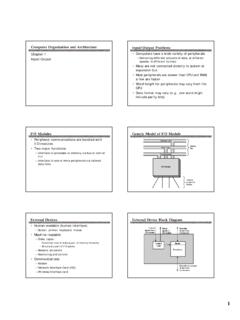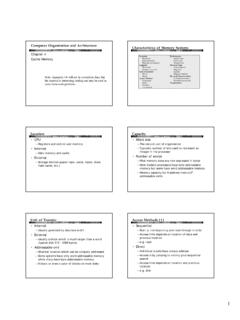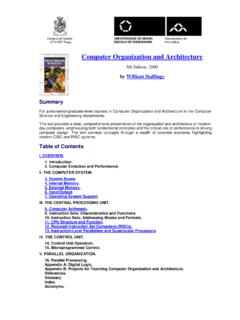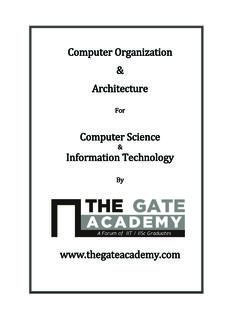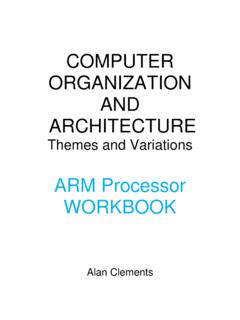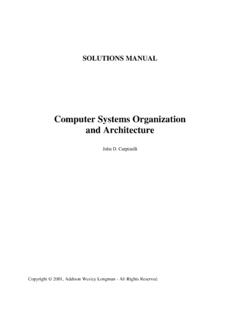Transcription of CS 2214 COMPUTER AR CHITECTURE & ORGANIZA …
1 CS 2214 COMPUTER architecture & organization FALL 2018 NYU School of Engineering Page 1 of 6 Handout No: 1 September 5, 2018 SYLLABUS1. Professor : Haldun Hadimioglu 2. Prerequisites : One of the following two : CS2204 (Digital Logic and State Machine Design, C- required) CS2134 (Data Structures & Algorithms, C- required) & MA2314 (Discrete Math)3. Textbook : COMPUTER organization and Design : The Hardware/Software Interface, D.
2 A. Patterson andJ. L. Hennessy, 5th edition, Morgan Kaufman, 2014. ISBN : 978-0-12-407726-3 Publisher s web site, has a large amount of material. Stu-dents are strongly suggested that they study them. The web site has various sectionsrelated to the chapters and tutorials, software packages and other supporting material. Make sure it is the MIPS version of the book ! It should not be ARM nor RISC-V. 4. What is asked from college graduates : Good technical and non-technical skills + competency + grit ! Adaptable, flexible and team player ! Problem solver + systems oriented in a global environment !
3 You may have also heard the following : You are creative and have learning as your target ! You know how to learn fast ! Good solid technical knowledge + learning fast + interpersonal skills You have analytical and synthesis skills You have team work skills : Interacting with people to solve problems ! You have good documentation skills ! You are a critical thinker ! You discover and explore ! You are lifelong learner !5. How to be successful in your college years and after graduation : Knowledge is infinite and it consists of pieces of information that are dependent on each other ininfinite ways. Learning is not instant !
4 It requires physical changes in the brain Plasticity ! That is, neuronsin your brain are rewired as you learn. Rewiring the brain is not easy. It requires constant effort Applying/using what is leaned is not instant ! One needs time to apply/use the knowledgeacquired, meaning additional rewiring in the brain is , students try to recover by themselves. They just take exams. Professors cannot help themsince these students are not around. It gets worse for students as the semester progresses and so no one cando anything It becomes a vicious cycle Those students who need help are not around to get help : 2 MTC Degrees : and in Electrical Engineering and degree in COMPUTER Science Involved in the undergraduate COMPUTER Engineering program administration Areas : COMPUTER architecture , parallel (multi-core) processing, reconfigurable and nano systemsNYU Tandon School of Engineering, COMPUTER Science and EngineeringSix MetroTech Center, Brooklyn, New York 11201 Tel : (646) 997-3101 Fax.
5 (646) 997-3609 NYU School of Engineering Page 2 of 6 CS 2214 Handout No : 1 September 5, 20186. Why COMPUTER architecture ? COMPUTER architecture is about designing computers, designingmicroprocessors, memory subsystems. Students who know hardware are good at software (Operating Systems + Applications).7. Course Objectives : What will you learn ? COMPUTER architecture & including instruction set designand COMPUTER organization , including the central processing unit (CPU, core) & memory Course Outcomes : What will you be able to do once the course is completed ?
6 Design and analyzecomputer architectures (instruction sets), CPUs (cores) and memory Course topics : CS 2214 is about digital systems examples include, microprocessors, GPUs, customchips, memory chips, etc. CS 2214 also studies instruction sets run by microprocessors and their design. It emphasizes designing microprocesors and memory components that make up computers. The finite-state machine (FSM) approach is used to design digital systems. 10. The course format :The course stresses what industry wants and categorizes them : Intellectual, technical and non-technical:1) The intellectual goals are that students learn how to learn fast and are critical thinkers.
7 This isnecessary during one s lifetime The more you learn, the better for you ! 2) Te c h n i c a l goals are for a successful technical career : Acquiring skills to be systems oriented and aproblem solver as well as acquiring the necessary course content which is digital systems : Main technical topic : Digital systems, such as microprocessors, computers, calculators,DVDs, iPhones. The course focuses on developing a COMPUTER , by designing its architectureand then the organization (microarchitecture) layers : Designing the architecture : Machine language instruction set design & programming.
8 Designing the organization includes learning the skills to design a COMPUTER with a singleprocessor (single-core) and understand its subsystems and their interaction. The proces-sor, one of the three subsystems of a COMPUTER , is the Central Processing Unit, the other two subsystems are the memory and Input/Output (I/O) controllers. The com-puter we design is named EMY and is based on a commercial microprocessor, the MIPS. Digital system design is in the context of state machine design & EMY COMPUTER whichis a subset of the MIPS ) The non-technical goals include acquiring and improving skills needed for interacting with andmanaging people in a global environment.
9 They are needed in the technical world which is team-based and is global. NYU School of Engineering Page 3 of 6 CS 2214 Handout No : 1 September 5, 201811. Course structure : 12. Course web page : NYU Classes : Course handout files are at the course web site13. CS 2214 Recitations : Recitations aim at reinforcing and complementing the lectures. They help students understand subjectsdiscussed in class better. Recitation sessions are given by teaching assistants (TAs).
10 Recitations cover new topics besides covering lecture topics in detail. They also present practicalaspects of topics covered during the lecture. In addition, the recitations are intended to discusshomework assignments. However, homework questions will not solved ! Students in each recitation section form 3- or 4-member teams by the third week of the members do the homework assignments together until the end of the semester. Students register to the recitation section that is for their lecture section. Each section has one hourand 50 minutes a week. Students need to attend their recitation section to be able to work withtheir teammates.
